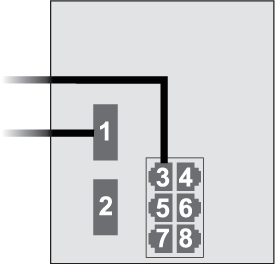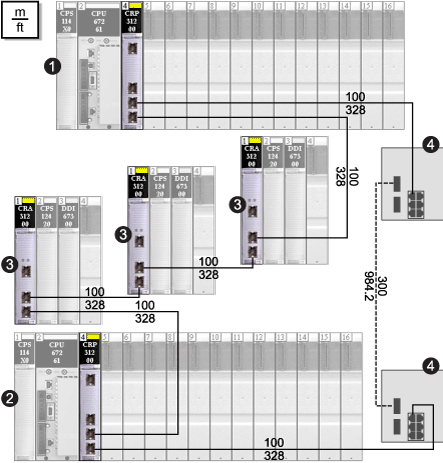Preconfiguration File Name
C15_CRPLinkHotStandbyLDVx.xx.cfg, where
Vx.xx references the version number of the file.
Use of this Preconfiguration
In some applications, you may want to separate the primary controller from the standby controller by a long distance. In a tunnel application, for example, you may want to install the 2 PLCs at opposite ends of the tunnel to lessen the likelihood that environmental damage to 1 will affect the other.
A fiber optic link is used between the 140CRP31200 heads in each local rack. Because the 140CRP31200 modules do not have fiber ports, the initial connections are made with copper cable. Two s, each with this preconfiguration downloaded, are used to transition from copper to fiber then back to copper.
Devices Supported by this Preconfiguration
The preconfiguration described here can be used with either of 2 DRS types:
-
A TCSESM063F2CU1 ConneXium extended managed switch, which supports multi-mode fiber cable
-
A TCSESM063F2CS1 ConneXium extended managed switch, which supports single-mode fiber cable
Both switches have 2 fiber ports and 6 copper ports.
With single-mode fiber cable, you can achieve distances on the main ring up to 15 km. With multi-mode fiber cable, you can achieve distances up to 2 km.
Predefined Port Connections
This preconfiguration supports 1 fiber connection (port 1 in the graphic below) and 1 copper connection (port 3) to the copper/fiber main ring.
This predefined configuration does not support the use of a sub-ring or any distributed I/O clouds. One copper port (port 8) is reserved for
port mirroring, i.e., for monitoring the status of the ports you previously selected in the switch’s port mirror web page.
NOTE: The default configuration of port 8 has port mirroring disabled.
|
Port
|
Type
|
Description
|
|
1
|
FX
|
fiber connection to the main ring
|
|
3
|
100Base-TX
|
copper connection from the 140CRP31200 to the main ring
|
|
2
|
FX
|
disabled fiber port; do not use
|
|
4
|
100Base-TX
|
disabled copper port; do not use
|
|
5
|
100Base-TX
|
disabled copper port; do not use
|
|
6
|
100Base-TX
|
disabled copper port; do not use
|
|
7
|
100Base-TX
|
disabled copper port; do not use
|
|
8
|
100Base-TX
|
port mirroring connection
|
NOTE: When you download this DRS predefined configuration file to a switch, the file provides a set of operating parameters that enable the switch to operate with high efficiency in the specified architecture.
Do not adjust the configuration parameters or alter the port usage from what is shown above. Changing the configuration parameters or the port assignments can compromise the effectiveness and accuracy of the switch and the performance of the remote I/O network.
You can enable/disable port mirroring and change the selection of the source ports that you want mirrored. Port mirroring is disabled by default. The destination port is set to port 8, and ports 1-7 are selected as source ports. Do not change the destination port. When using port mirroring, select the ports, for which you want to analyze the traffic, as the source ports. When you finish troubleshooting, disable port mirroring.
A Long-haul Hot Standby Link
The following diagram depicts a network with a primary local rack (1) and a secondary Hot Standby rack (2) located at a distance from the primary rack. The main ring consists of 3 remote I/O drops (3), connected to each rack. Two copper-to-fiber DRSs provide a long-haul fiber connection in support of the Hot Standby functionality.
1
the primary local rack, with a remote I/O head module
2
the secondary Hot Standby rack, also with a remote I/O head module
3
3 remote I/O drops connected via a copper daisy-chain
4
2 DRSs configured for long-haul Hot Standby support, connected via a fiber cable greater than 100 m long 
